
Racial disparities in primary prevention of incontinence among older adults at nursing home admission
Sign Up to like & getrecommendations! Published in 2017 at "Neurourology and Urodynamics"
DOI: 10.1002/nau.23065
Abstract: Maintaining continence of nursing home (NH) residents promotes dignity and well‐being and may reduce morbidity and healthcare treatment costs. To determine the prevalence of older continent adults who received primary prevention of incontinence at NH… read more here.
Keywords: nursing home; incontinence; primary prevention; prevention ... See more keywords

Three‐dimensional translabial ultrasound assessment of urethral supports and the urethral sphincter complex in stress urinary incontinence
Sign Up to like & getrecommendations! Published in 2017 at "Neurourology and Urodynamics"
DOI: 10.1002/nau.23193
Abstract: The pathophysiological mechanism of incontinence is multifactorial. We evaluated the role of 3D‐4D ultrasound in the assessment of the fascial supports of the urethra and the urethral sphincter complex (USC) for diagnosing stress urinary incontinence. read more here.
Keywords: sphincter complex; stress urinary; urethral sphincter; incontinence ... See more keywords

The role of male slings in post prostatectomy incontinence: ICI‐RS 2015
Sign Up to like & getrecommendations! Published in 2017 at "Neurourology and Urodynamics"
DOI: 10.1002/nau.23264
Abstract: Post prostatectomy stress urinary incontinence can significantly impact on quality of life and is bothersome for patients. The artificial urinary sphincter is still considered the gold standard surgical treatment. Male slings are an alternative surgical… read more here.
Keywords: incontinence; role male; male slings; post prostatectomy ... See more keywords

6th International Consultation on Incontinence. Recommendations of the International Scientific Committee: EVALUATION AND TREATMENT OF URINARY INCONTINENCE, PELVIC ORGAN PROLAPSE AND FAECAL INCONTINENCE
Sign Up to like & getrecommendations! Published in 2018 at "Neurourology and Urodynamics"
DOI: 10.1002/nau.23551
Abstract: Scientific report of the proceedings from the 6th International Consultation on Incontinence, (Tokyo 2016). read more here.
Keywords: consultation incontinence; international consultation; 6th international; incontinence ... See more keywords

Effect of severity of urinary incontinence on quality of life in women
Sign Up to like & getrecommendations! Published in 2018 at "Neurourology and Urodynamics"
DOI: 10.1002/nau.23568
Abstract: While the effect of different types of incontinence on the quality of life (QoL) has been clearly documented, the information about the impact of incontinence severity on QoL in women is lacking. Therefore, we investigated… read more here.
Keywords: effect; incontinence; quality life; incontinence quality ... See more keywords

Development of an ICF‐based questionnaire for urinary and/or fecal incontinence (ICF‐IAF): The male patients' perspective using focus groups
Sign Up to like & getrecommendations! Published in 2019 at "Neurourology and Urodynamics"
DOI: 10.1002/nau.24034
Abstract: This study seeks to explore barriers faced by and resources available to male patients with urinary (UI) and/or fecal incontinence (FI) based on the ICF framework. As a result, this study contributes to the development… read more here.
Keywords: icf; fecal incontinence; urinary fecal; incontinence ... See more keywords

Exploring the relation between obesity and urinary incontinence: Pathophysiology, clinical implications, and the effect of weight reduction, ICI‐RS 2018
Sign Up to like & getrecommendations! Published in 2019 at "Neurourology and Urodynamics"
DOI: 10.1002/nau.24072
Abstract: To evaluate the relationship between obesity and urinary incontinence (UI) and to determine the effect of weight reduction on the severity of incontinence. read more here.
Keywords: weight reduction; incontinence; obesity urinary; urinary incontinence ... See more keywords

Voxel‐wise lesion mapping of self‐reported urinary incontinence in multiple sclerosis
Sign Up to like & getrecommendations! Published in 2019 at "Neurourology and Urodynamics"
DOI: 10.1002/nau.24194
Abstract: Besides spinal lesions, urinary incontinence may be attributed to particular cerebral lesion sites in multiple sclerosis (MS) patients. We intended to determine the contribution of suprapontine lesions to urinary incontinence in MS using a voxel‐wise… read more here.
Keywords: voxel wise; incontinence; multiple sclerosis; wise lesion ... See more keywords

Anatomical predictors of long‐term urinary incontinence after robot‐assisted laparoscopic prostatectomy: A systematic review
Sign Up to like & getrecommendations! Published in 2021 at "Neurourology and Urodynamics"
DOI: 10.1002/nau.24652
Abstract: There is scarce evidence of anatomical risk factors that might affect long‐term post‐prostatectomy incontinence (PPI) in patients undergoing robot‐assisted laparoscopic prostatectomy (RALP). This systematic review aims to identify anatomical measurements in preoperative magnetic resonance imaging… read more here.
Keywords: laparoscopic prostatectomy; long term; systematic review; robot assisted ... See more keywords

Urodynamic characterization of giggle incontinence in children
Sign Up to like & getrecommendations! Published in 2021 at "Neurourology and Urodynamics"
DOI: 10.1002/nau.24725
Abstract: Giggle incontinence is a rare condition resulting in excessive urinary incontinence with laughter, where bladder function is otherwise “normal.” Urodynamic descriptions of the condition to date are limited. We believe that giggle incontinence has characteristic… read more here.
Keywords: incontinence children; urodynamic characterization; giggle incontinence; incontinence ... See more keywords

Incontinence and sleep disturbances in young children: A population‐based study
Sign Up to like & getrecommendations! Published in 2022 at "Neurourology and Urodynamics"
DOI: 10.1002/nau.24866
Abstract: Nocturnal enuresis (NE), daytime urinary incontinence (DUI), fecal incontinence (FI), as well as sleep and behavioral problems are common in young children. The aim of this study was to analyze the association of sleep and… read more here.
Keywords: young children; sleep disturbances; incontinence sleep; incontinence ... See more keywords